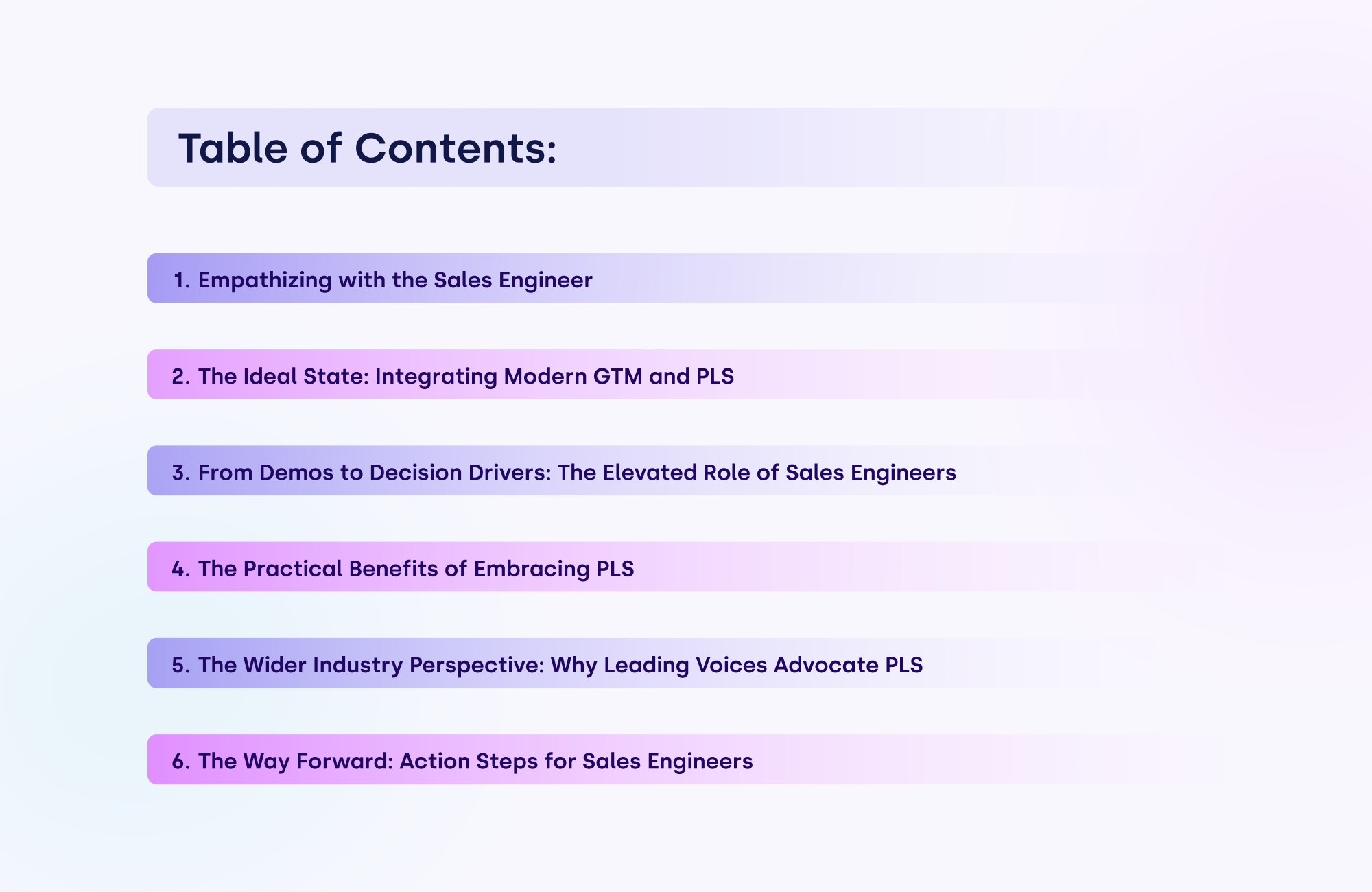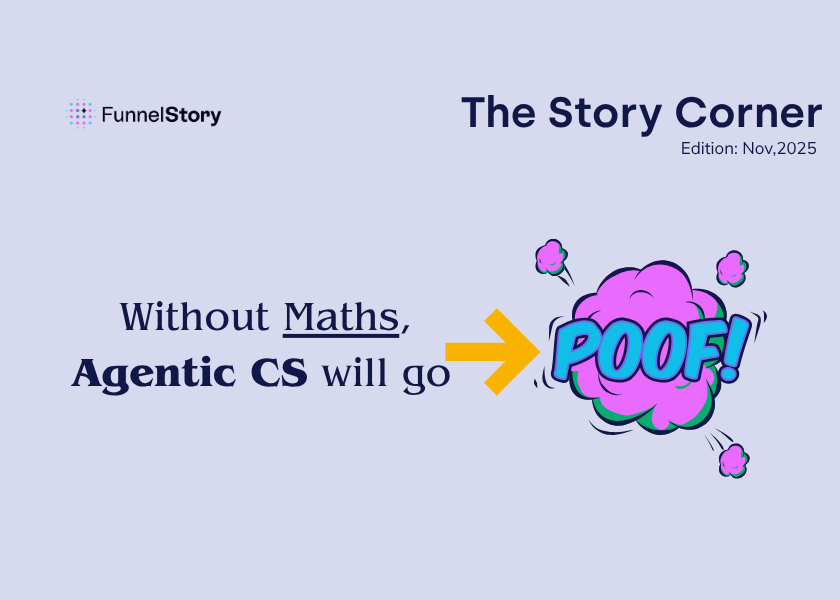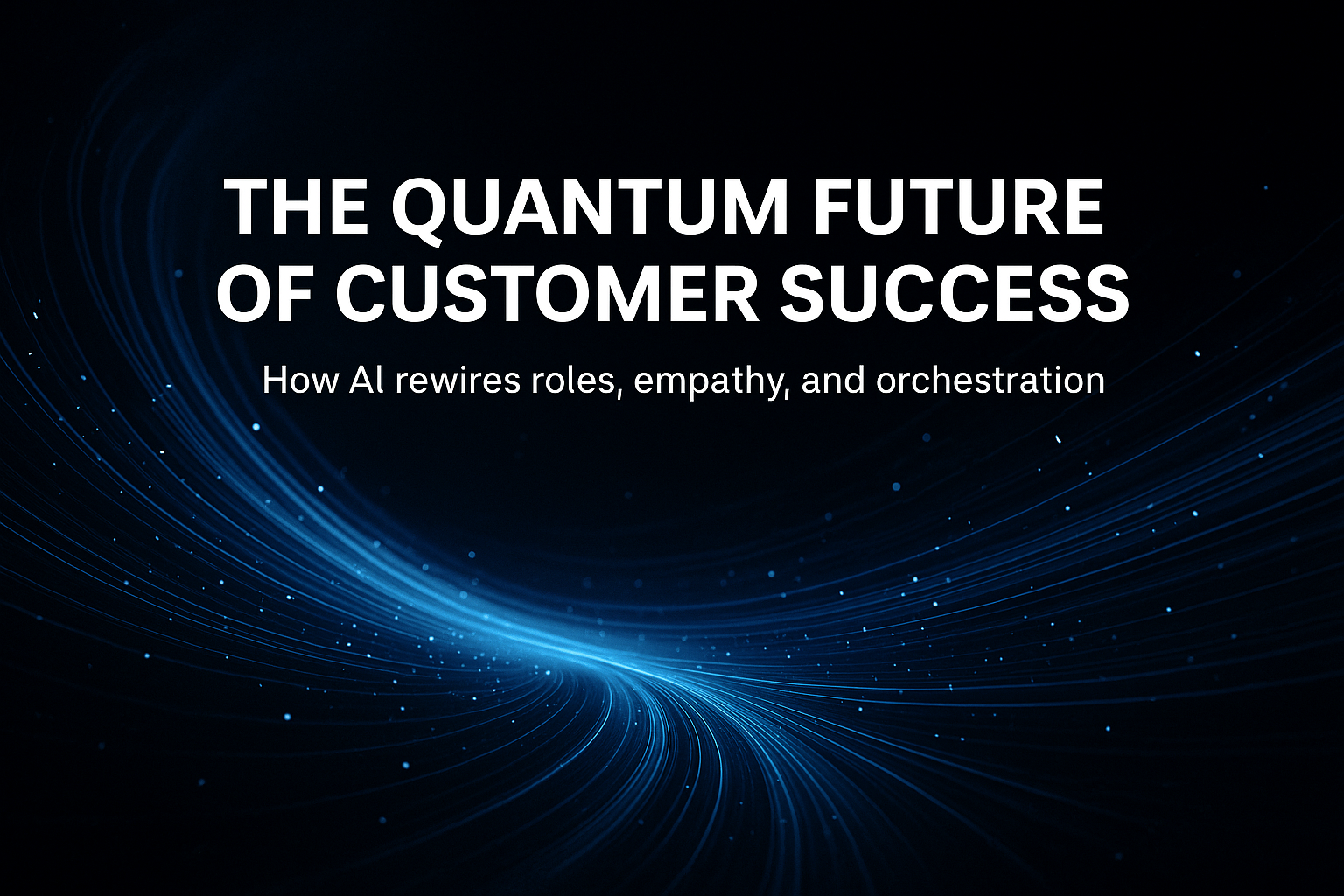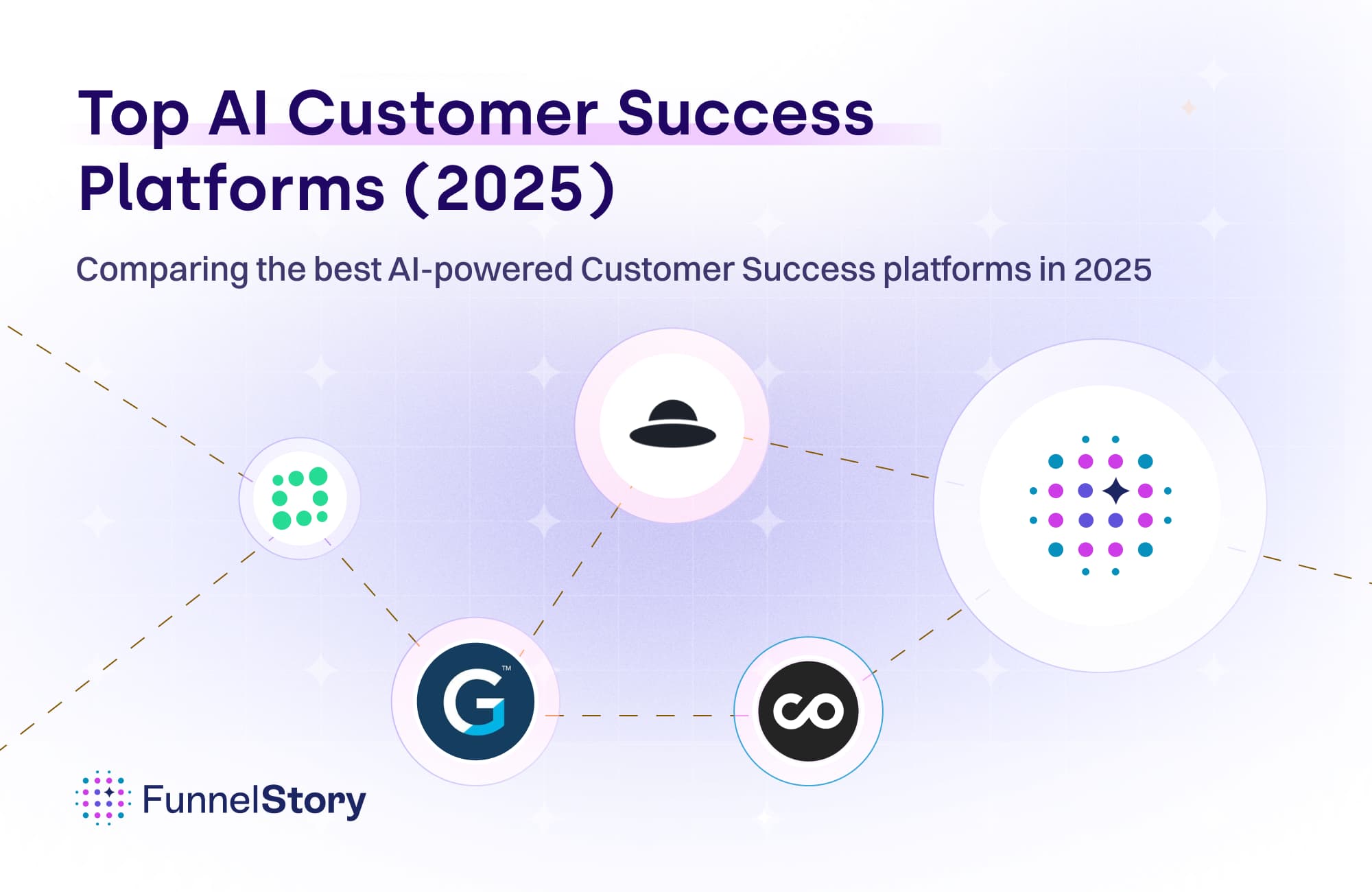In this article
How Sales Engineers Can Amplify Success with a PLS Strategy
Discover the transformative power of Product-Led Sales strategy for Sales Engineers. Elevate from demo providers to decision-making stakeholders, seamlessly integrating with modern Go-To-Market motions.

By Alok Shukla
Cofounder and CEO
Oct 20, 2023
9 min read
Sales Engineers have emerged as crucial players in the rapidly changing world of sales, bridging the technical and commercial realms. Often seen as the backbone of tech-focused sales teams, these professionals wear many hats. They not only explain the intricacies of products but also tailor their pitches to resonate with varied technical and non-technical audiences. Dive deeper into the nuanced role of these experts in our piece on the intuition of sales engineers, where we explored their innate ability to gauge client needs.
Parallelly, the sales landscape is witnessing a paradigm shift with the rise of Product-Led Sales (PLS). No longer are sales discussions dominated by high-level abstract benefits. Instead, the focus has shifted to actual product capabilities and user experiences. But what's driving this change? At its core, PLS is about harnessing the product itself as the primary driver for growth. This means putting the product at the forefront, allowing potential clients to recognize its value through direct interaction via trials or hands-on demos. We’ve analyzed the nuances of this approach in our article on getting started with product-led growth in B2B, underscoring its significance in today’s sales climate.
As we delve into this topic, we'll uncover the synergy between Sales Engineers and PLS, emphasizing how the former can leverage the latter to revolutionize their approach and outcomes.

Empathizing with the Sales Engineer
Sales Engineers often find themselves at the crossroads of technology and commerce, a position rife with challenges. Their role isn't just about showcasing a product's technical prowess; it's about weaving a narrative that resonates with potential clients, answering their questions, and addressing pain points.
One of the predominant challenges these engineers grapple with is the demand for deep technical expertise. They must be adept at understanding the intricacies of products, often down to the code level, to respond to detailed queries. This is not a one-time learning curve; continuous education becomes imperative with evolving products and technological landscapes. Our thorough exploration into the intuition of sales engineers sheds light on how they adeptly navigate these ever-shifting sands.
Simultaneously, Sales Engineers can’t only be trapped in the technical web. They must be equally skilled in sales tactics, understanding client psychology, and tailoring their approach to various stakeholders, from tech teams to C-level executives. The juggling act doesn't stop here; these engineers often play a pivotal role in post-sales support, ensuring smooth product adoption and troubleshooting issues.
Yet, amidst these demands, there's an art to balancing technical prowess with sales flair. It's not about delving into deep tech talk or inundating prospects with features. It's about presenting solutions and telling a story that aligns with a client's needs and visions. As they walk this tightrope, supporting strategies like PLS can be invaluable, offering tools and approaches that make their tasks more intuitive, automated, data-driven, and therefore more impactful. As we'll discover in subsequent sections, this balance can lead to transformative results for the PreSales function and the organizations they represent.
The Ideal State: Integrating Modern GTM and PLS
Today's competitive business landscape demands agility, adaptability, and a sharp focus on customer needs. Enter the modern Go-To-Market (GTM) strategy—a dynamic approach that places the customer and your product at the center of a buying process, ensuring that products resonate with their target audiences - a.k.a PLS.
Compared to traditional sales-led strategies, PLS emphasizes the product as the primary driver of customer acquisition, expansion, and retention. It aligns the product's value with customer needs, ensuring that users immediately see its benefits, a point elaborated in our guide on getting started with Product-Led Growth in B2B.
When PLS is seamlessly overlaid on your GTM motion, organizations reap unparalleled benefits. Firstly, there's improved alignment between product development, marketing, and sales teams, ensuring that all units move cohesively towards shared goals - pre and post-sales. This unified approach results in faster time-to-market and a sharper competitive edge.
Furthermore, this integration means that feedback loops are tighter. Companies can quickly pivot based on real-time user feedback, ensuring that products remain relevant and appealing.
In essence, synthesizing GTM and PLS creates an environment where products meet and anticipate market demands, driving growth and fostering innovation. As we progress, we'll delve deeper into how Sales Engineers, armed with PLS, can be at the forefront of this transformative approach.
From Demos Jockeys to Decision Drivers: The Elevated Role of Sales Engineers
For years, the role of Sales Engineers (SEs) has been stereotyped and confined to mere demo provisioners. Picture a highly technical individual whose sole task is to showcase product functionalities without actively participating in the broader sales narrative. However, this image couldn't be further from the truth today, especially with the evolving landscapes of sales and product strategies.
Modern PreSales teams are not just the bridge between the product and its potential users but crucial decision-makers and influencers within the sales process. An SE's intuition, built on technical know-how and sales flair, guides potential clients toward a solution that best fits their needs. This balance between product expertise and sales insights is something we've discussed in-depth in our article on the intuition of sales engineers.
Enter Product-Led Sales (PLS), which equips SEs to rise beyond their traditional roles. By embracing PLS, SEs can understand the product's intrinsic value and target their communication in a way that resonates with the client's unique challenges and objectives. This shift from guesswork and gut feelings to more data-driven insights make them critical weapons for driving strategic decisions at the deal level and at the organizational level.
Furthermore, with their new visibility into trial data, SEs can actively shape the product's future iterations by providing feedback directly from the field, linking the sales process to product development. In essence, the narrative is changing. No longer are Sales Engineers mere conduits of information; they are now the linchpin in a customer-centric sales approach, driving decisions and influencing product trajectories. The next chapters will delve further into the tangible benefits of such a shift, elucidating how organizations can harness this transition for unparalleled growth.
The Practical Benefits of Embracing PLS
Product-Led Sales (PLS) is not just another buzzword in the sales domain; it presents tangible and strategic benefits that can significantly impact an organization's bottom line. SEs find themselves at the epicenter of this transformation, reaping multifaceted advantages.
Faster Sales Cycles: Traditional sales processes, often linear and lengthy, can be sped up with PLS. By making the product the primary sales experience during PoCs, prospects can experience the solution's value firsthand - unencumbered by your team. For instance, a study highlighted in our article on reducing product onboarding times demonstrated that PLS-driven onboarding can expedite user understanding and adoption, leading to quicker conversions.
Scale: PLS facilitates largely self-serve product trials, allowing you to reach a broader audience without exponentially increasing resourcing. And we’re willing to bet that your cost of running PoCs is high.
Resourcing: With the data from your product-led motion you can also make better resourcing decisions. The reason is, that when you know where your customers stand during their PoC, you know how to deploy your team's time. This ensures that personnel limitations don't bottleneck sales efforts and that your team supports the best opportunities or those that are more at risk.
Data-Driven Decisions: One of the more underrated benefits of PLS is its wealth of data. SEs and product teams can make data-driven decisions for future iterations or forecasting by tracking user interaction and feedback during product-led engagements. Say goodbye to the days of tracking PoCs manually and with missing data.
In summary, embracing PLS offers PreSales organizations an immediate competitive edge. You get your hands on better PoC visibility and more account data, all of which allows your team to work smarter, not harder - oh, and make decisions with even more precision. The following section will delve deeper into industry perspectives and actionable steps for SEs to harness the full potential of PLS.
The Wider Industry Perspective: Why Leading Voices Advocate PLS
Product-Led Sales (PLS) has captured the attention of thought leaders and influencers within the Product-Led Growth (PLG) space. Their advocacy isn't mere hype but based on substantial evidence of the transformative power of making your GTM motion more product-led.
Brian Halligan, CEO of HubSpot, has observed a fundamental shift in growth strategies. He noted, "The traditional way of growing a company is top-down. Today, it’s bottom-up. It's how humans want to buy and sell, so let's adapt and give them the tools to do it." This perspective highlights the human-centric aspect of PLS, echoing the sentiment that today's sales strategies must be closely aligned with evolving customer preferences.
Aileen Lee, founder and partner at Cowboy Ventures, further amplifies the power of PLS. She suggests, "In a world of product-led growth, it's not about selling. It's about creating a product so valuable that it sells itself." This insight underscores the importance of product value in driving sales decisions.
Even a report from McKinsey signals that the movement towards a more product-centric approach in the B2B space is not just hype but a paradigm shift here to stay.
The consensus among these thought leaders is clear: PLS offers unparalleled advantages, and this is especially true for the PreSales function where PoCs are commonplace. By leveraging the product as the primary tool for engagement and sales, SEs can engage more authentically, address pain points proactively, and close deals more efficiently.
The Way Forward: Action Steps for Sales Engineers
Embarking on the journey towards a more product-led approach might seem daunting, but with the right steps, your PreSales team can smoothly transition and harness the full potential of PLS.
Recognize the Shift: Understand that transitioning to a PLS strategy significantly changes how you approach sales. Given the magnitude of this shift, it's prudent to start on a smaller scale.
Begin with a Pilot: Identify a segment or part of your product that can be self-serve. This will allow prospects to experience the value firsthand and can serve as a test bed for refining and scaling your PLS approach.
Redefine the Customer Journey: Self-serve funnels aren't the same as your current, and predominantly, sales-led motion. It's crucial to start with your customers. This involves working with your cross-functional GTM team to understand your core users (including buying personas), their motivations, and their buying journey. Ensure all paths, points of friction, and handoffs are mapped and well understood.
Design and Launch Your Experience Funnel: Your new self-serve funnel should seamlessly guide prospects through the product experience. Ensure it's intuitive, engaging, and communicates the product's value proposition. Also, surround your customers with self-serve educational content!
Equip with the Right Tech Stack: Integrate tools and platforms that not only help measure and track user behavior but also facilitate gathering feedback. Such insights are crucial in refining your PLS approach. But don't let your Product team force their analytic tools on you - your needs are different.
Engage Early and Often with Product Teams: As you gather insights from the front lines, collaborate closely with product managers and engineers. This partnership ensures that your real-time feedback gets translated into tangible product improvements.
Embrace Data and Analytics: Go beyond your typical sales metric numbers. Delve deep into product analytics to gain a nuanced understanding of user behavior, preferences, and challenges. Using these insights, tailor your sales pitches to resonate more effectively with prospects.
By embracing these actions, Sales Engineers can navigate the product-led landscape more confidently and drive meaningful engagements that lead to successful sales outcomes.



